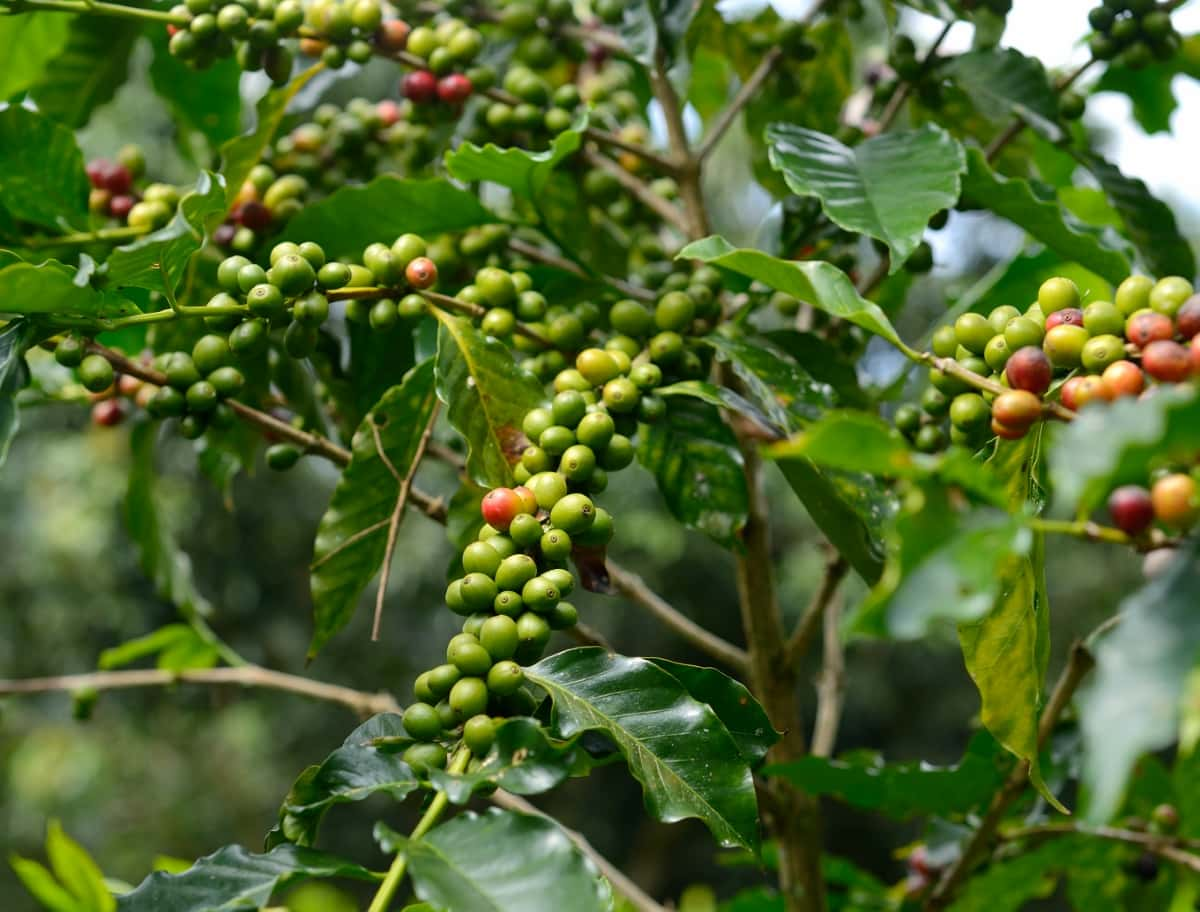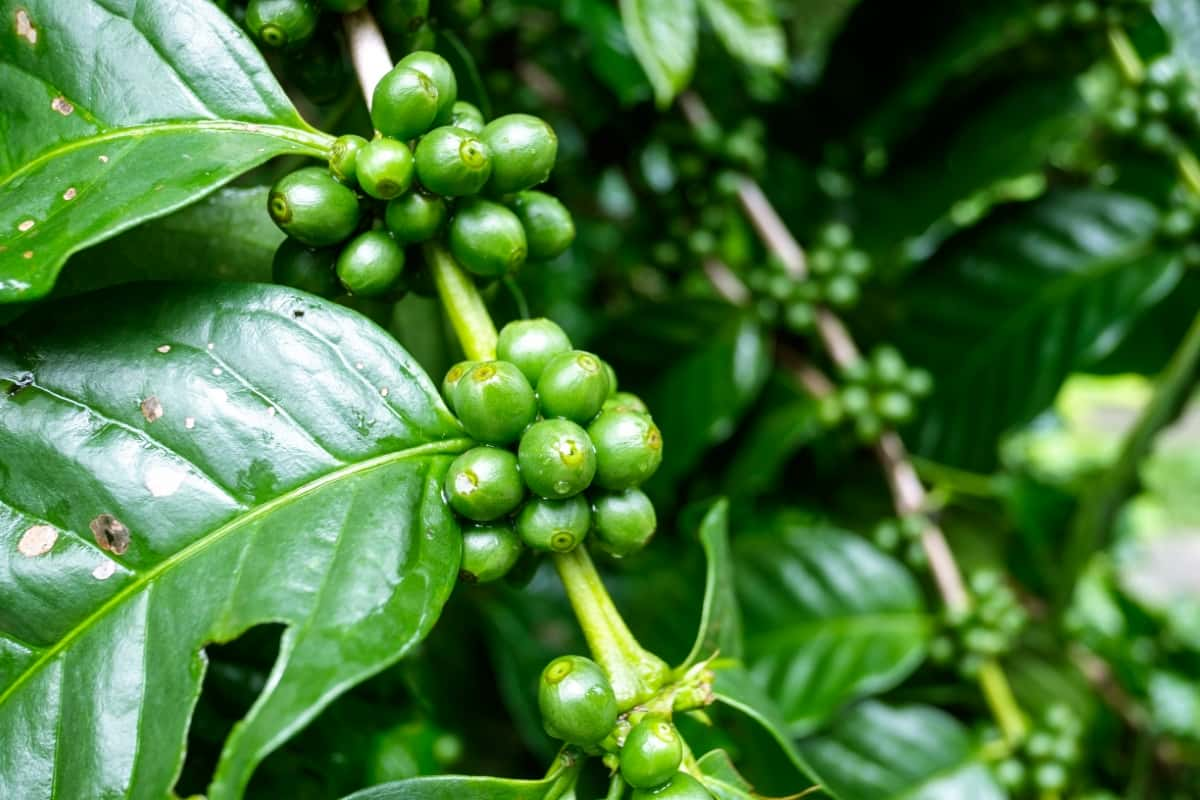Coffee plants, scientifically known as Coffeea, are small trees or shrubs that belong to the Rubiaceae family. These plants thrive in warm climates with abundant rainfall. Coffee plants are beautiful additions to any garden, allowing you to harvest your beans for that perfect cup of joe.

Understanding the Causes of Coffee Plant Leaves Turning Brown: A Comprehensive Analysis
Why are the Coffee plant leaves turning brown? One common cause behind brown Coffee plant leaves is environmental factors. Sunlight and temperature play crucial roles in maintaining leaf health. Extreme temperatures can cause stress and browning. Another factor to consider is nutritional deficiencies. Just like us humans, plants require a balanced diet too. Lack of nutrients such as nitrogen, potassium, or iron can manifest as brown spots on the leaves.
Pest infestations and diseases also have their fair share of blame for browning leaves. Overwatering or underwatering can lead to leaf browning due to root stress or nutrient imbalances. While understanding these causes is vital, prevention and treatment strategies are equally important for maintaining healthy Coffee plants with lush green foliage.
Understanding the Role of pH Levels in Soil: How It Affects Coffee Plant Leaf Color
The soil’s pH level is crucial in determining the health and color of Coffee plant leaves. The soil pH scale measures the acidity or alkalinity of soil. Coffee plants thrive best in slightly acidic soil with a pH level of 6 and 6.5. When the soil becomes too acidic (below pH 6), it can result in yellowing and browning of Coffee plant leaves.
Maintaining proper soil pH for Coffee plants is essential for optimal growth and vibrant foliage. Regularly testing your soil’s pH levels using a simple test kit allows you to make necessary adjustments using organic amendments like compost or sulfur for acidification. Understanding how pH affects Coffee plant health can ensure your beloved plants receive optimum nutrition and display healthy leaf coloration throughout their lifecycle.
The Impact of Environmental Factors on Coffee Plant Leaves: Exploring the Role of Sunlight and Temperature
Factors affecting the health and appearance of Coffee plant leaves are the environment in which they are grown. Environmental factors such as sunlight and temperature determine whether Coffee plants thrive or struggle. Sunlight is important for photosynthesis, the process by which plants convert sunlight into energy. Too much sunlight can be detrimental to Coffee plant leaves.
Temperature also plays a significant role in maintaining healthy Coffee plant leaves. To ensure optimal growth conditions for your Coffee plants, providing them with moderate levels of indirect sunlight throughout most of the day is important. If your Coffee plant’s leaves turn brown or yellow, consider adjusting its position to receive adequate but not excessive light exposure.
Nutritional Deficiencies and Coffee Plant Health: Unravelling the Connection to Brown Leaves
One common nutrient deficiency that leads to brown leaves is nitrogen deficiency. Nitrogen plays an important role in the chlorophyll production, which gives leaves their green color. Without enough nitrogen, the leaves may turn yellow or even brown. Another important nutrient for Coffee plants is iron. Iron deficiency can cause leaves turn yellow with interveinal chlorosis, where the veins remain green while the areas between them turn pale or white. Potassium deficiency can also contribute to leaf browning.
When there’s not enough potassium available, it affects overall leaf health and can lead to Coffee plant leaves turning brown on the edges or tips of the leaves. To prevent nutritional deficiencies and maintain healthy foliage, it’s crucial to ensure that your Coffee plants receive balanced nutrition through proper fertilization.
Pest Infestations and Diseases: Identifying Culprits Behind Brown Coffee Plant Leaves
One common pest that affects Coffee plants is the Coffee borer beetle. These tiny insects bore into the branches and stems of the plant, causing damage that leads to leaf discoloration. Another troublesome critter is the spider mite, which feeds on plant sap and causes Coffee leaf yellowing and browning. Diseases can also take a toll on your precious Coffee plant. One such disease is Coffee Leaf Rust, caused by a fungus called Hemileia vastatrix.
This devastating disease results in brown spots on the leaves, eventually leading to defoliation if left untreated. To identify these causes behind brown Coffee plant leaves, closely examine your plants for any signs of pests or diseases. Look out for chewed or distorted leaves, webbing from spider mites, or powdery orange spores indicating Coffee Leaf Rust. Regularly inspect your Coffee plants for any signs of trouble and practice good hygiene by removing fallen leaves promptly.
Watering Practices and Coffee Plant Health: Investigating the Link to Leaf Browning
Watering practices play a crucial role in the overall health of Coffee plants. Improper watering can lead to various issues, including leaf browning. Understanding the link between watering and leaf discoloration is essential for maintaining vibrant foliage. Coffee plants require regular but not excessive watering. Overwatering can drown the roots and prevent proper nutrient absorption, leading to brown leaves. On the other hand, underwatering deprives the plant of essential moisture, causing stress and ultimately resulting in foliage problems.
In case you missed it: Creating Seedbeds for Coffee Seed Germination and Planting

Overfertilization and Chemical Burn: Examining the Effects on Coffee Plant Leaves
Overfertilization and chemical burn are two factors that can have a detrimental effect on Coffee plant leaves. While fertilizing your Coffee plants is important for their growth and health, using too much fertilizer or applying it incorrectly can lead to leaf browning. When Coffee plants are overfertilized, they receive excessive nutrients that they cannot absorb. This imbalance in nutrient uptake can result in burning the plant’s roots and foliage.
Chemical burn, on the other hand, occurs when Coffee plants come into direct contact with certain chemicals such as pesticides or herbicides. It is crucial to follow proper fertilizing practices to prevent overfertilization and chemical burns. Additionally, always follow instructions carefully when using chemical products near your plants.
Effective Strategies for Preventing and Treating Brown Leaves in Coffee Plants
One of the main concerns for Coffee plant owners is dealing with brown leaves. There are effective approaches to prevent and treat this problem. Ensuring proper watering practices is crucial. Overwatering or underwatering can both lead to brown leaves. To avoid overwatering, ensure the soil has good drainage and only water when the top inch feels dry. On the other hand, if you notice your Coffee plant leaves curling or drooping before turning brown, it may be a sign of underwatering.
Regularly fertilize your Coffee plant using a balanced fertilizer formulated specifically for indoor plants to ensure they receive essential nutrients like nitrogen, phosphorus, and potassium. Watch for pests and diseases that can cause leaf discoloration. Spider mites and fungal infections are common causes behind brown spots on Coffee plant leaves. Use organic pest control ways or consult a professional if necessary.
Coffee Plant Leaves Turning Yellow: Causes and Solutions
One common cause of yellow leaves in Coffee plants is overwatering. So, ensure you’re not drowning your Coffee plant with excessive watering. Another cause behind yellow leaves could be insufficient sunlight. Coffee plants thrive in bright indirect light, so if yours isn’t getting enough exposure to sunshine, it may start showing signs of distress by turning yellow.
Place your plant near a window that receives adequate light throughout the day. Nutritional deficiencies are also known to turn Coffee plant leaves yellow. Consider fertilizing your plant regularly with a balanced fertilizer specifically formulated for houseplants. Common pests such as mealybugs or spider mites, causing damage and discoloration.
Treat pest problems promptly using organic insecticides or natural remedies like neem oil. By identifying these potential causes for yellowing leaves in your Coffee plants and implementing appropriate solutions tailored to each situation, you’ll be well-equipped to revive their lush green appearance and ensure their overall health and vitality.
Coffee Plant Leaves Drooping: Causes and Solutions
Why is my Coffee plant droopy? One potential cause of drooping leaves is overwatering. Coffee plants prefer moist soil but don’t appreciate sitting in waterlogged conditions. So, make sure to provide adequate drainage and avoid watering too frequently. Another cause behind droopy leaves could be underwatering. If your Coffee plant isn’t receiving enough water, its leaves will wilt and droop as a sign of dehydration.
In case you missed it: Weed Management in a Coffee Plantation: Control with Chemical, Cultural, Mechanical, and IPM Strategies

To remedy this, check the soil’s moisture level regularly and adjust your watering schedule accordingly. Inadequate light exposure can also lead to droopy Coffee plant leaves. These plants require bright but indirect sunlight for optimal growth. Nutrient deficiencies can cause leaf drooping as well. Coffee plants need nutrients like nitrogen, phosphorus, and potassium for healthy foliage growth. Ensure you provide balanced fertilizer specifically formulated for acid-loving plants like Coffee trees.
Conclusion
Growing your Coffee plant allows you to enjoy the satisfaction of nurturing a living organism from seedling to maturity. It can be a rewarding experience watching your plant flourish under your care. Providing the right amount of light and maintaining optimal temperature ranges will help prevent browning or yellowing leaves.
- Feed Your Flock for Less: Top 10 Tips to Save on Chicken Feed
- Ultimate Guide to Ossabaw Island Hog: Breeding, Raising, Diet, and Care
- Hatching Answers: The Top 10 Reasons Your Chickens Aren’t Laying Eggs
- Eggs and Economics: Breaking Down the Cost of Raising Backyard Chickens
- Defend Your Greens: Proven Methods to Keep Iguanas Out of Your Garden
- Ultimate Guide to Cinnamon Queen Chicken: A Comprehensive Guide for Beginners
- Ultimate Guide to California Tan Chicken: Breeding, Raising, Diet, Egg-Production and Care
- Ultimate Guide to Marsh Daisy Chicken: Breeding, Raising, Diet, and Care
- 10 Types of Chicken Farming Businesses You Can Start for Profits